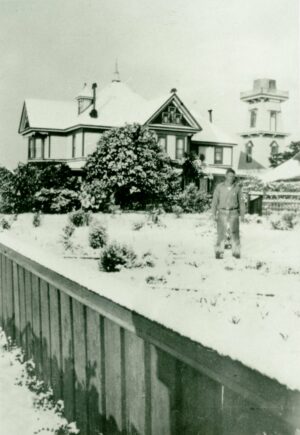
the unidentified man is the Preston carriage house, which became the Art
Center gallery. 1932
Everyone likes to talk about the weather and the archives of the Kelley House include a fat folder labeled “Weather.” Here we look at storms and rain, though there is enough material to write a whole article JUST on the 1964 floods.
A huge storm in 1865 produced the following news. “Old Boreas, with his howling legions, has been among us playing the very deuce by his mad pranks… It was impossible to walk the streets without being capsized…”
Rain caused flooding that put the mill on Big River flat under water. Ships anchored in the bay disappeared. Noyo and Caspar had damage to their mills. Little River had three ships wrecked on the beach. It was the worst storm seen since the settlement of the Coast.
Appreciation was expressed in 1885 for stagecoach drivers — these men worked in any conditions, encountering pitch darkness, deep mud, pelting rain, sweeping blasts of wind, day and night, so passengers and mail could get to their destinations.
Since logging companies used river drives to float logs to the mill at tidewater, heavy rainfalls were a blessing to them. In 1888, heavy rain washed 40,000 logs down Big River and Caspar had 8,000 logs arrive, while Little River got 5,000. Booms across the mouth of the river held them until they could be pulled into the mill and turned into lumber.
In the 1885 storm, “rain came down in torrents” followed by snow, a rare occurrence on the Coast, and the wind blew a perfect gale. Eleven windmills were destroyed or twisted into a “very mad appearance.” In January 1909, 19.58″ of rain fell. In 1914, “supersaturated hillsides came down, blocking and wrecking wagon roads and railroads, and overflowing rivers ran mad, damaging and destroying bridges… The Mendocino bridge was visited by a crowd of sight-seers, who remained hours to watch the heavy swells toss the huge logs about like straws.”
The temperature dropped to 24 degrees in Mendocino City in January 1917 and icicles six feet long hung below the log deck at the mill. In 1937, five inches of rain fell in 24 hours in December and hailstones the size of marbles pelted the town. Cars stalled in waters three feet deep covering the Navarro highway, twenty bridges in the county were taken out by high waters. “Old T. Pluvis was hitting off at a pretty good lick himself about this time.”
Mendocino City got a picture postcard snowfall February 21, 1962, really making the area look like New England. December of 1964 produced massive flooding from snows melted in the mountains by warm rain. “Old Man Winter came in like a lion, bringing more than a generous amount of rain…” — like 4.38 inches in 24 hours. Roads and railroads washed away along with homes and businesses. Dynamite was used on a mass of debris piling up under the Noyo bridge. Highway 101 at Hopland had five feet of water on it for a short time.
In 1989, it snowed again and froze. Stores sold out of film and cameras as locals decided it was an event worth recording for posterity. Acme Automotive in Fort Bragg sold out 150 sets of chains to people who had to travel east. I was Mendocino Middle School librarian at the time and let kids out of class to go play in the snowfall as I taught them to catch snowflakes on the tips of their tongues. (I grew up back East and learned this skill early in life.)
Many thanks to Merlin Tinker who found 60+ years of rainfall totals abandoned in the old offices of Caspar Lumber Company. He brought them to the Kelley House to be preserved, so we know today that the lowest rainfall was 18″ in 1923 and 19″ in 1976; and high water years were 56″ in 1914 and 65″ in 1973. Later records from the old Wind and Weather store in Fort Bragg show 73″ of rain in 1997.
Weather is fun and journalists love to write about it. If you want more details, especially whole newspapers about the 1964 flooding, stop by the Kelley House Museum weekday afternoons and ask to see them. Call 707-937-5791 for more information.